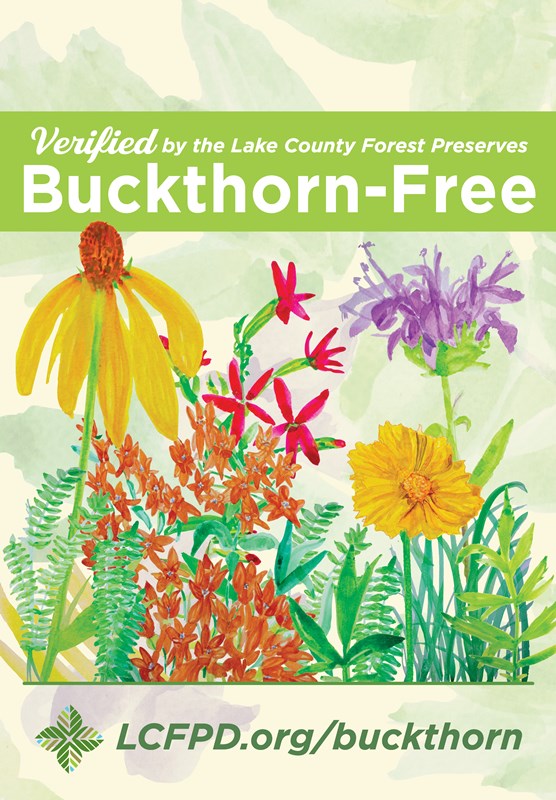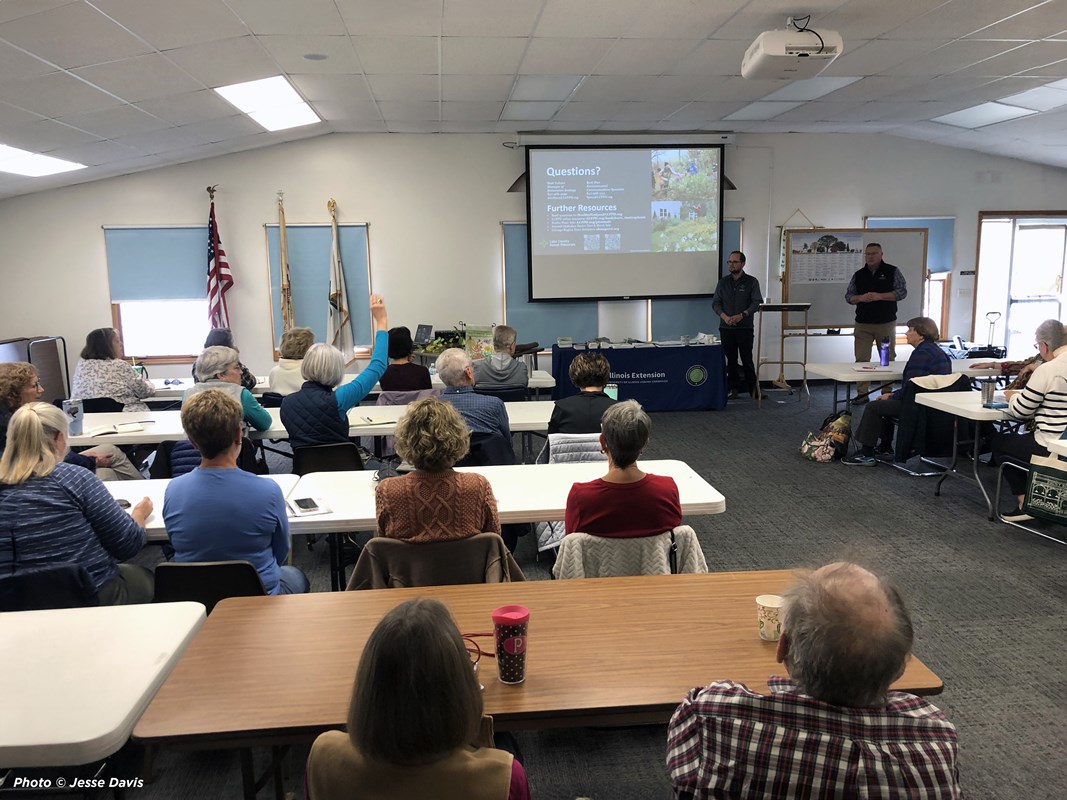The spread of invasive species is a major factor contributing to ecosystem change and instability throughout Chicagoland. Invasive species displace or wipe out native species, damage infrastructure, and threaten human livelihoods.
In Lake County, the invasive species common, or European, buckthorn (Rhamnus cathartica) is of particular concern. Buckthorn accounts for 52.2% of the county’s trees. We aim to eliminate buckthorn from all forest preserves and reduce it by 50% countywide by reaching out to private landowners, working with Lake County schools, and teaming up with partners.
The Buckthorn Stops Here
Buckthorn-Free Garden Flags
Native gardens are something to see. Is your home landscape buckthorn-free? Do you live in Lake County, Illinois?
If you answered yes, apply below to receive a FREE commemorative garden flag.
Garden flags are supported by a grant from the Preservation Foundation of the Lake County Forest Preserves.
The 12.5”x18” flag is made of durable vinyl and features original watercolors of native plants by Forest Preserves staff. The metal stand, which comes with the flag, is 3 feet tall and all in one piece—no assembly required! Two rubber stoppers and one anti-wind clip are also included.

To qualify for a flag, you must upload two to six photos of your entire landscape demonstrating that it is free of buckthorn.
Flags are not only for homeowners. Any property in Lake County, Illinois is eligible to receive a flag, including businesses, schools, homeowners associations, faith institutions and other organizations. If you have connections to any properties owned by an organization, encourage them to manage buckthorn and apply for a flag.
Wide-angle photos of larger portions of the property are preferred over photos of individual flowers and flowerbeds. One flag per property per year. Qualified residents may pick up their flag at our General Offices, 1899 W. Winchester Road, Libertyville, IL 60048. A metal stand is included with the flag.
“My family and I removed a large amount of buckthorn throughout our property. We are working on replacing other non-native and invasive species with natives to improve soil health, manage rainwater and improve the overall health of the ecosystem of the yard. We do not use chemicals or fertilizers on our property. The changes have resulted in many more butterfly, beneficial insect, bird and mammal species making our yard their home.”—Deerfield Homeowner Jennifer
“We inherited lots of buckthorn hedges when we moved here, nothing growing under them or near them … Buckthorn are now all gone and replaced with mostly natives—trees, shrubs, grasses, woodland/savanna perennials, etc. and we have all sorts of bugs, birds, amphibians, etc. that have moved in since … Just one oak tree, put in two decades ago, has way more going on in and around it than a whole, yard-long row of buckthorns … Now we discover something new going on in the yard every other day it seems. Bonus: compliments from neighbors passing by!”—Mark, Lake County resident
“Buckthorn was killing our native old oaks, destroying everything else that grows. Choking and poisoning everything, spreading all over Illinois. You don’t realize how bad it is until you see how beautiful it is without it. It has taken five years of very hard work (we did it ourselves). But we are finally free! We tried to plant as many native plants as we could find. Now if only we could get the neighbors with shared property lines to understand.”—Tanya, Lake County resident
Buckthorn-Free Application Form
If you are unable to fill out the form or have questions, please call 847-367-6640 or email HealthyHedges@LCFPD.org.
Identify Buckthorn
Fall is a good time to identify buckthorn and plan for removal efforts over the winter. Matt Ueltzen, manager of restoration ecology, shares tips on buckthorn identification, buckthorn berries, and a simple strategy to get started with buckthorn removal.
Remove Buckthorn
Matt Ueltzen, manager of restoration ecology, and Stewardship Ecologist Kelly Schultz share tips on how to remove buckthorn safely and effectively from a home landscape.
Healthy Hedges Recording
In this recording of our Healthy Hedges presentation, learn how and why to remove buckthorn from Environmental Communications Specialist Brett Peto and Matt Ueltzen, manager of restoration ecology.
Herbicide Tips and Tricks
Native Landscaping Resources
Ready to get started with native landscaping and invasive species removal and replacement? Visit our digital resources hub and join the Healthy Hedges movement.
Native Plant Resources
Before and After Buckthorn Removal
Use the arrows below to view three areas in the preserves before and after buckthorn removal. The difference is significant!
A New Fall Fashion
Environmental Communications Specialist Brett Peto shares how you can help make buckthorn eradication a new fall fashion in our Lake County Nature blog archive.
Learn More on our Blog
Buckthorn Removal in Progress Sign
Are you in the process of removing buckthorn from your property, but not quite buckthorn-free? Download, print and display this “Buckthorn Removal in Progress” sign to let your neighbors know you care about the health of plants, animals—and people!
Buckthorn Removal in Progress Sign
Healthy Hedges Presentations
Want to learn even more about buckthorn removal and replacement, and have a chance to ask your questions to our experts in person? Book a free Healthy Hedges presentation for your community group.
Forest Preserves staff will discuss the impacts of buckthorn on local habitats and how to manage this invasive shrub in your home landscape. They’ll share best practices for buckthorn removal and suggest great replacement plants. Become inspired to join the movement toward a healthier Lake County. Adults.
Presentations are available to community groups, businesses, homeowners associations, public libraries, garden clubs, nonprofit organizations, park districts, village and city councils, and other groups by request. The typical duration is 60–90 minutes, including time for Q&A. The duration can be adjusted based on audience needs.
Please call 847-367-6640 or email HealthyHedges@LCFPD.org to request a presentation. Advance notice of four to six weeks or more is preferred. Availability subject to staff schedules.

Native Landscaping Presentations
We offer a program for adult and senior groups titled Invasive Species, Native Landscaping and You, available in-person and virtually.
What are the top 13 invasive plant species found in Lake County? Learn identifying characteristics, practical tips and the best times of year to manage them. Plus, discover key steps to introduce native flowers, shrubs and trees into your home landscape. This program is offered FREE of charge to Lake County residents.
For further inquiries or to book a presentation, please contact us by phone at 847-367-6640 or by email. We ask that programs be booked at least two weeks in advance. See program pricing here.
Buckthorn Eradication Pilot Project
In 2015, we began a pilot project to eradicate buckthorn in a 2,900-acre landscape surrounding Middlefork Savanna in Lake Forest. Bounded by I-94 and Routes 176, 43 and 60, this area contains the 687-acre preserve and about 700 public and private properties. We are working to include these landowners in a large-scale push to eradicate buckthorn locally, called the Buckthorn Eradication Pilot Project.
Learn More in our Horizons Magazine
I understand the ecological impacts of buckthorn, but it offers privacy screening. What can I do to preserve privacy?
This is a common perspective. For many people, their yards are a reflection of who they are and an important part of what makes their property feel like home. The good news is buckthorn removal can be completed over time; it doesn’t have to be an overnight project. Additionally, native shrubs and trees can provide privacy screening once they are established in your yard. You can remove invasive species like buckthorn and still preserve the aesthetics of your home.
I heard buckthorn is actually good for animals. Is that true?
Unfortunately, this is inaccurate. Buckthorn can be quite harmful to many animals that live on or near your property. For example, its fruits offer little nutritional value for wildlife and have a diuretic effect on birds, which often spread buckthorn seeds across property lines.
Isn’t it bad to remove trees, even if they are buckthorn?
While removing trees can feel counterintuitive, buckthorn is uniquely suited to outcompete many species that are native to our region, which severely degrades the overall health of local ecosystems. Entire woodlands, habitats and even yards can become infested with buckthorn overgrowth. This can choke out the next generations of native plants, particularly oaks. Removing buckthorn and replacing it with native plants is beneficial to the local landscape.
What are some of the alternative plants available?
There are great alternative, low-maintenance, native plants you can plant in your yard. Consider native plants such as wild plum (Prunus americana), any native species of hawthorn (Crataegus spp.), American hazelnut (Corylus americana), wild black currant (Ribes americanum), witch hazel (Hamamelis virginiana) and butterfly weed (Asclepias tuberosa). See more recommendations on our Native Plants and Healthy Hedges webpage.
What is the Lake County Forest Preserves’ role in buckthorn removal?
As principal guardian of Lake County’s open space and natural areas since 1958, we are focused on preservation, restoration, education and recreation. The reality is that buckthorn does not observe property boundaries. To most effectively tackle the issue, we want to encourage private landowners to remove buckthorn from their properties and communities as we remove it from the preserves.
Contact Us
Need help with invasive species removal and replacement or another landscaping issue? Please fill out the contact form below. If you are unable to fill out the form or prefer to inquire another way, please call 847-367-6640 or email HealthyHedges@LCFPD.org.
Volunteer Opportunities